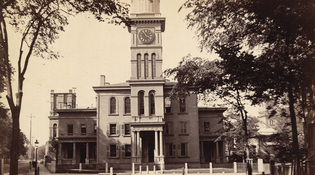 loading
loading
Old YaleWhen Yale was a farming schoolJudith Ann Schiff is chief research archivist at the Yale University Library.  Manuscripts & ArchivesThough it lacked fields, crops, and livestock, South Sheffield Hall (shown here c. 1874) was the center of agricultural research and training in Connecticut. View full imageThe fact that Yale today has a one-acre farm, established in 2003 to grow organic produce for the dining halls, may seem a radical departure from its academic past. But, in fact, the university has a distinguished agricultural heritage. In 1846, Yale established this country's first professorship in agriculture. Sixteen years later, Yale became one of America's initial group of land-grant colleges, along with Rutgers, Iowa State, Kansas State, and others. Yale's first farmer-scientist was John Pitkin Norton, who studied analytical chemistry at Yale with Benjamin Silliman, Class of 1796, in the early 1840s, and then traveled to Scotland for more training. When Norton returned, Silliman convinced the Corporation (Yale's governing body) to organize a department of education in applied science. Norton shared leadership of the department with Silliman's son, Benjamin Silliman Jr. ’37, a professor of practical chemistry. From this department evolved both Yale's School of Science (later renamed the Sheffield Scientific School) and Yale's Graduate School (which in 1861 awarded America's first PhDs). Norton's textbook, Elements of Scientific Agriculture, published in 1850, was widely read. After he died of tuberculosis in 1852 at the age of 30, he was replaced by John Addison Porter ’42. But it was one of Norton's students, Samuel William Johnson, who would become the nation's leader in agricultural education. Johnson studied abroad as well, and by 1857 was professor of analytical and agricultural chemistry at the fledgling School of Science. The purpose of the school was to educate undergraduates and graduate students: "the engineer, the agriculturist, the metal worker, the miner, the chemist, and the mechanic will each find instruction planned for his professional wants." In 1860, Johnson and Porter held a national conference on agriculture, the first of its kind in America. It lasted a full month, with 26 speakers and more than 500 attendees. The New York Times opined, "We hope to see not only Yale, but all our colleges turning a portion of their attention from the languages of nations who have long since passed away, and directing it more to those truths of science." Scientific American agreed: "To see Yale College stepping out from among the mists of antiquity and the graves of dead languages, and 'taking up the shovel and the hoe,' is certainly one of the signs of the times." Yale's conference and the extensive news coverage it received may have helped further the passage of the 1862 Morrill Land-Grant Colleges Act. Under the act, each state received 30,000 acres of federal land per member of Congress; proceeds from sale of the lands were to endow "Colleges for the benefit of Agriculture and the Mechanic Arts." Sheffield was the only institution that applied for the money from Connecticut's 180,000 acres. When the state declared that its land-grant monies would go to cover tuition for in-state Sheff students, 40 full scholarships became available for Connecticut residents attending Yale. The school established the Agriculture Course, which included plant and animal husbandry, sciences, and comparative history of agriculture in other countries. Yale's reputation in agriculture continued to flourish. In 1868, Johnson published How Crops Grow, which became the leading introductory text for 40 years and was translated into five languages. Another enduring contribution was his establishment of the Connecticut Agricultural Experiment Station in 1875. The station, housed at Sheff in its early years, served as a model for the agricultural experiment stations now found in every state. In the late 1880s, state reports on the school were laudatory, and Sheff was annually awarding free tuition to 50 or 60 Connecticut residents a year. The State Grange, however, complained that farmers were not receiving the full benefit of the Morrill Act because Sheff's admission standards were too high. In 1893, the General Assembly—which included a large agricultural voting bloc—established Storrs Agricultural College as the state's land-grant school. (Storrs College is now the University of Connecticut.) In compensation, Yale was awarded nearly $155,000, the equivalent of Connecticut's entire land-grant fund of $135,000, plus interest. Sheff's longtime dean Russell H. Chittenden, Class of 1875PhB, ’80PhD, wrote in his history of the school that the land grant had benefited Connecticut not only because of the scholarships, but also because "indirectly the state had profited greatly from the growing prestige of a scientific institution recognized throughout the country as a school of the first rank." Sheff continued to offer agricultural courses into the early twentieth century. In 1901, Sheff professors organized Yale's forestry school, now the School of Forestry & Environmental Studies. Today, much of its science and policy work explores the same subjects Samuel Johnson put forward in the introduction to his text: "How the air, soil, plant, and animal, stand related to each other in a perpetual round of the most beautiful and wonderful transformations—these are some of the grand questions that come before us; and they are not less interesting to the philosopher or man of culture, than important to the farmer who depends upon their practical solution for his comfort; or to the statesman, who regards them in their bearings upon the weightiest of political considerations."
The comment period has expired.
|
|